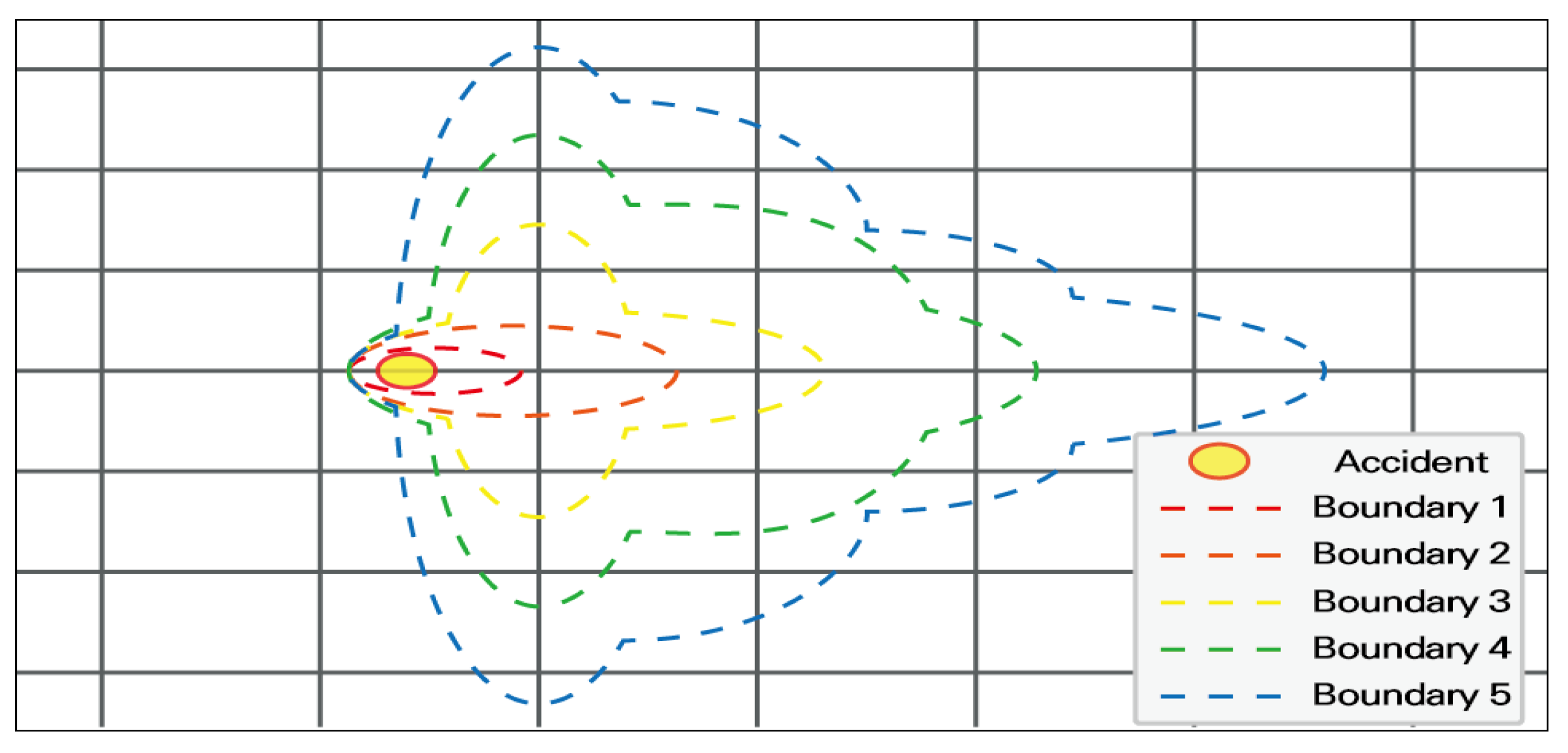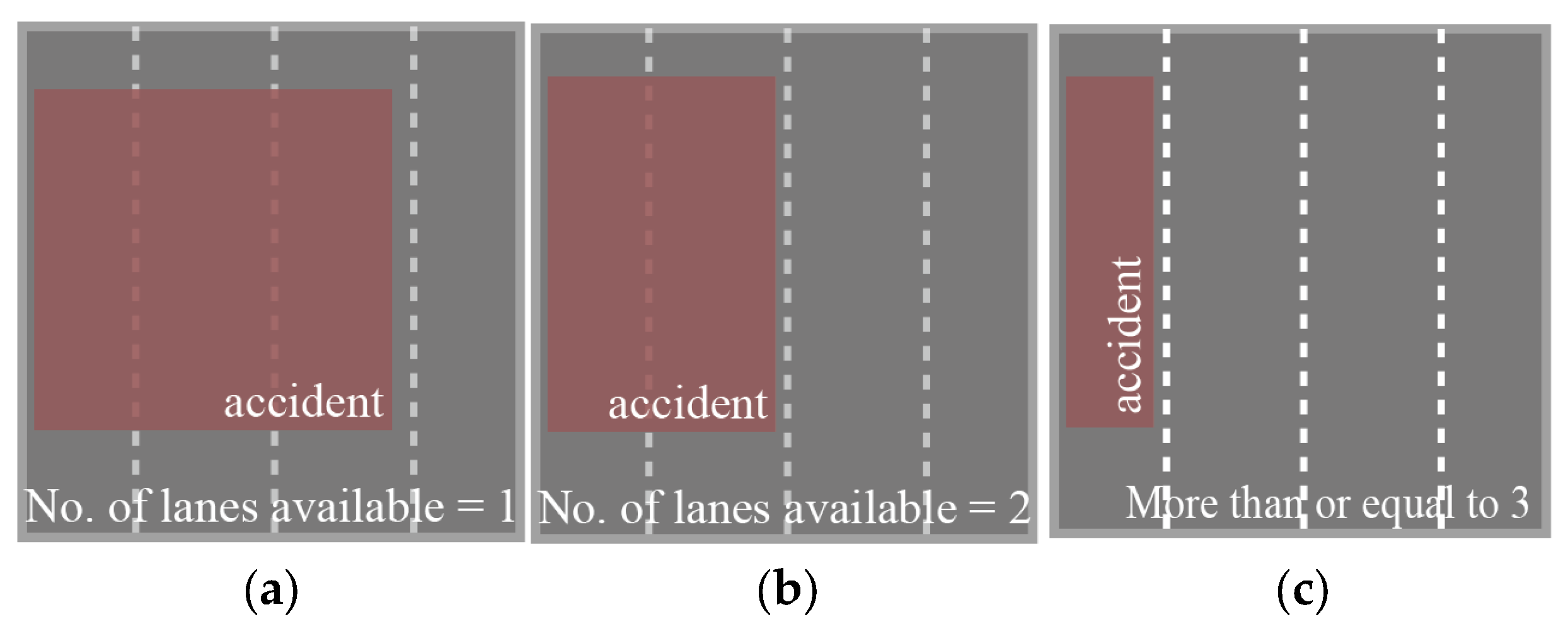Study on Traffic Incident Management Boundary Based on Gis and Its Historical Travel Time Data †
Abstract
:1. Introduction and Objectives
2. Data Collection and Analysis
2.1. Materials and Methods
2.2. Results
2.2.1. CASE 1 (Number of Available Lanes Is One)
2.2.2. CASE 2 (Number of Available Lanes Is Two)
2.2.3. CASE 3 (Number of Available Lanes Is More than Three)
3. Conclusions
Author Contributions
Funding
Institutional Review Board Statement
Informed Consent Statement
Data Availability Statement
Conflicts of Interest


| Incident Duration (min) | Boundary | Time Period (min) after Accident Occurrence | |||||||
|---|---|---|---|---|---|---|---|---|---|
| 0~5 | 5~10 | 10~15 | 15~20 | 20~25 | 25~30 | 30~35 | 35~40 | ||
| >30 | 1 | −9.4% | 1.6% | 0.7% | 12.0% | 2.2% | 8.8% | 0.8% | 1.8% |
| 2 | −3.6% | −1.6% | 3.9% | 2.2% | 5.1% | 5.4% | 5.4% | 1.6% | |
| 3 | −2.1% | 3.1% | 1.0% | 1.7% | 2.8% | 6.2% | 2.2% | 7.5% | |
| 4 | −1.3% | 1.1% | 3.8% | 2.4% | 2.5% | 4.7% | 2.7% | 3.9% | |
| 5 | −3.7% | 3.1% | 3.4% | 3.6% | 2.8% | 6.1% | 6.2% | 4.7% | |
| 30~60 | 1 | −10.2% | 0.5% | 1.4% | −1.1% | 1.6% | 5.9% | 1.5% | 7.1% |
| 2 | −14.9% | 4.1% | 2.2% | 5.8% | 14.8% | 1.5% | 1.8% | 7.4% | |
| 3 | −6.4% | 7.1% | 0.1% | 3.2% | 0.3% | 8.3% | 3.9% | 3.1% | |
| 4 | −2.7% | 0.9% | 3.3% | 6.4% | 2.2% | 2.7% | 3.3% | 4.6% | |
| 5 | −2.7% | 3.7% | 3.2% | 2.6% | 3.8% | 3.1% | 2.4% | 3.8% | |
| 60 ≤ | 1 | −18.6% | −0.2% | −4.1% | −3.8% | 14.8% | 46.8% | 2.0% | 25.2% |
| 2 | −7.5% | 6.3% | −5.9% | 0.9% | 9.5% | 3.0% | 2.0% | 3.6% | |
| 3 | −6.5% | 1.0% | 7.2% | −1.5% | 1.7% | 5.2% | 8.0% | 3.0% | |
| 4 | −5.7% | 3.6% | 4.7% | 5.0% | 3.0% | 0.2% | 5.7% | −0.1% | |
| 5 | −4.9% | 2.9% | 1.9% | 7.4% | 1.3% | 2.4% | 5.3% | 4.5% | |
| Incident Duration (min) | Boundary | Time Period (min) after Accident Occurrence | |||||||
|---|---|---|---|---|---|---|---|---|---|
| 0~5 | 5~10 | 10~15 | 15~20 | 20~25 | 25~30 | 30~35 | 35~40 | ||
| >30 | 1 | −9.6% | 3.0% | 3.5% | 4.7% | 1.8% | 5.9% | −0.3% | 3.1% |
| 2 | −8.6% | 3.9% | 2.9% | 7.2% | 3.3% | 6.8% | 8.1% | 2.7% | |
| 3 | −1.7% | 2.4% | 3.4% | 4.5% | 2.6% | 1.3% | 5.3% | 5.5% | |
| 4 | −2.5% | 2.4% | 3.0% | 4.5% | 3.7% | 2.9% | 6.1% | 2.3% | |
| 5 | −3.9% | 3.1% | 4.4% | 3.5% | 2.4% | 3.4% | 3.1% | 2.8% | |
| 30~60 | 1 | −13.0% | 2.3% | 12.1% | 2.1% | 1.1% | 4.9% | 0.1% | 7.5% |
| 2 | −6.7% | 4.1% | −1.0% | 5.1% | 1.7% | 8.9% | 4.9% | 4.8% | |
| 3 | −3.2% | 1.9% | 3.4% | 2.0% | 2.3% | 2.1% | 2.3% | 3.9% | |
| 4 | −3.5% | 3.1% | 4.8% | 1.9% | 3.0% | 3.3% | 3.9% | 2.9% | |
| 5 | −2.2% | 3.2% | 2.2% | 3.5% | 3.0% | 3.3% | 2.8% | 2.7% | |
| 60 ≤ | 1 | −17.3% | −1.1% | −5.4% | 4.8% | 1.5% | 2.6% | 1.2% | 2.0% |
| 2 | −8.0% | −2.9% | 0.6% | 3.0% | 7.3% | 0.2% | 1.4% | −0.3% | |
| 3 | −2.1% | 1.5% | 1.7% | 2.1% | 3.8% | 8.1% | 2.1% | 1.0% | |
| 4 | −3.8% | 2.3% | 4.4% | 3.1% | 3.7% | 2.2% | 2.8% | 2.2% | |
| 5 | −2.6% | 1.7% | 2.9% | 2.5% | 2.6% | 3.2% | 2.9% | 3.6% | |
| Incident Duration (min) | Boundary | Time Period (min) after Accident Occurrence | |||||||
|---|---|---|---|---|---|---|---|---|---|
| 0~5 | 5~10 | 10~15 | 15~20 | 20~25 | 25~30 | 30~35 | 35~40 | ||
| >30 | 1 | −6.4% | 2.4% | 3.3% | 5.5% | 3.4% | 8.0% | 4.8% | 4.2% |
| 2 | −6.4% | 2.5% | 0.7% | 5.6% | 4.5% | 6.0% | 5.1% | 2.1% | |
| 3 | −3.8% | 1.7% | 2.8% | 2.8% | 3.9% | 3.6% | 4.2% | 4.9% | |
| 4 | −2.7% | 2.8% | 1.2% | 3.3% | 2.7% | 3.2% | 3.4% | 4.2% | |
| 5 | −1.9% | 2.8% | 2.1% | 2.4% | 2.6% | 3.1% | 2.2% | 3.7% | |
| 30~60 | 1 | −9.5% | −0.6% | 1.3% | 1.4% | 2.5% | 4.9% | 2.0% | 5.7% |
| 2 | −5.9% | −0.5% | 8.6% | −0.4% | 5.1% | 5.6% | 1.5% | 2.7% | |
| 3 | −1.3% | −0.6% | 1.5% | 2.8% | 3.8% | 3.2% | 3.4% | 4.3% | |
| 4 | −3.3% | 2.1% | 2.9% | 1.4% | 3.3% | 1.7% | 2.7% | 2.4% | |
| 5 | −2.2% | 2.0% | 2.2% | 3.0% | 2.2% | 3.8% | 2.9% | 1.5% | |
| 60 ≤ | 1 | −12.9% | 3.5% | −2.6% | 5.4% | 1.4% | 6.8% | 2.8% | 5.6% |
| 2 | −8.0% | 4.2% | −0.3% | 12.5% | 3.8% | 4.6% | 2.4% | 3.7% | |
| 3 | −6.8% | 1.0% | 3.6% | 2.6% | 0.8% | 2.4% | −0.1% | 2.3% | |
| 4 | −1.8% | 2.6% | 7.3% | 1.8% | 1.5% | 1.8% | 2.8% | 2.3% | |
| 5 | −2.9% | 2.9% | 1.8% | 5.3% | 1.8% | 3.4% | 3.4% | 3.0% | |
Disclaimer/Publisher’s Note: The statements, opinions and data contained in all publications are solely those of the individual author(s) and contributor(s) and not of MDPI and/or the editor(s). MDPI and/or the editor(s) disclaim responsibility for any injury to people or property resulting from any ideas, methods, instructions or products referred to in the content. |
© 2023 by the authors. Licensee MDPI, Basel, Switzerland. This article is an open access article distributed under the terms and conditions of the Creative Commons Attribution (CC BY) license (https://creativecommons.org/licenses/by/4.0/).
Share and Cite
Kim, D.H.; Kim, J.-T. Study on Traffic Incident Management Boundary Based on Gis and Its Historical Travel Time Data. Eng. Proc. 2023, 36, 22. https://doi.org/10.3390/engproc2023036022
Kim DH, Kim J-T. Study on Traffic Incident Management Boundary Based on Gis and Its Historical Travel Time Data. Engineering Proceedings. 2023; 36(1):22. https://doi.org/10.3390/engproc2023036022
Chicago/Turabian StyleKim, Dong Hyeop, and Jin-Tae Kim. 2023. "Study on Traffic Incident Management Boundary Based on Gis and Its Historical Travel Time Data" Engineering Proceedings 36, no. 1: 22. https://doi.org/10.3390/engproc2023036022
APA StyleKim, D. H., & Kim, J.-T. (2023). Study on Traffic Incident Management Boundary Based on Gis and Its Historical Travel Time Data. Engineering Proceedings, 36(1), 22. https://doi.org/10.3390/engproc2023036022






